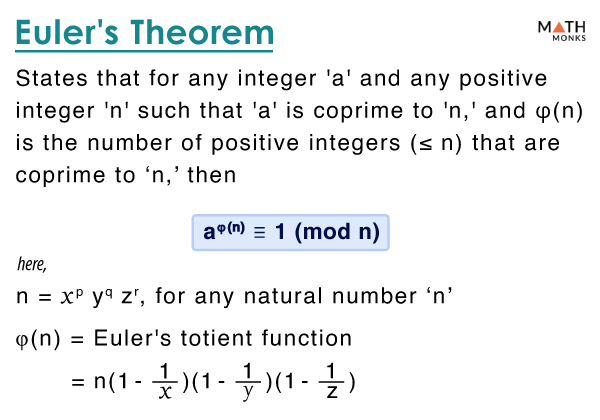Euler’s theorem or Euler’s totient theorem is an expansion of Fermat’s little theorem, which states that:
If an integer ‘a’ is relatively prime to any positive integer ‘n,’ and φ(n) is the number of positive integers (≤ n) that are relatively prime to ‘n,’ then
aφ(n) ≡ 1 (mod n)
Here,
n = xp yq zr, for any natural number ‘n’
φ(n) = ${n\left( 1-\dfrac{1}{x}\right) \left( 1-\dfrac{1}{y}\right) \left( 1-\dfrac{1}{z}\right)}$, is known as Euler’s totient function or Euler’s function.
It has many applications in elementary number theory, including the theoretical basis for RSA cryptography, where a wide range of positive integers are used.
Proof
To prove Euler’s Theorem, we rely on several fundamental concepts from number theory, including the properties of Euler’s totient function and the concept of modular arithmetic. Here’s a simplified version of the proofs.
Using Residue Classes
Let us consider the elements r1, r2, …, rφ(n) of (ℤ/n)×, the congruence classes of integers that are relatively prime to ‘n.’
Since multiplication by ‘a’ is a function from the finite set (ℤ/n)× to itself and has an inverse for a Є (ℤ/n)×, then {ar1, ar2, …, arφ(n)} equals (ℤ/n)×
Now, considering the product of all the elements of (ℤ/n)× in modulo n, we get
r1r2…rφ(n) ≡ (ar1)(ar2)…(arφ(n))
⇒ r1r2…rφ(n) ≡ aφ(n) r1r2…rφ(n)
⇒ 1 ≡ aφ(n)
⇒ aφ(n) ≡ 1 (mod n), and thus, the theorem is proven.
Using Lagrange’s Theorem
The elements in (ℤ/n) with multiplicative inverses form a group under the multiplication, denoted by (ℤ/n)×, which has φ(n) elements.
Let us assume that the subgroup consisting of the powers of ‘a’ has ‘d’ elements
The elements of the subgroup are {1, a, a2, …, ad – 1), where ‘d’ is the multiplicative order of ‘a’
By Lagrange’s theorem,
d|φ(n)
⇒ φ(n) = dk, for some integer k
Since ad ≡ 1 (mod n)
aφ(n) ≡ adk ≡ (ad)k ≡ 1k ≡ 1 (mod n)
Hence, Euler’s theorem is proven.
Corollary
From Euler’s theorem, we get several corollaries. Some are discussed below.
Corollary 1: If n Є ℤ+, a Є ℤ, and ‘a’ coprime to ‘n,’ then aφ(n) + 1 ≡ a (mod n)
Proof
Here, aφ(n) + 1 ≡ aφ(n) ⋅ a (mod n)
Since, according to Euler’s theorem, aφ(n) ≡ 1 (mod n), then
aφ(n) ⋅ a ≡ 1 ⋅ a ≡ a (mod n)
Thus, aφ(n) + 1 ≡ a (mod n) is proven.
Corollary 2: If n Є ℤ+, a Є ℤ, ‘a’ coprime to ‘n,’ and b ≡ 1 (mod n), then ab ≡ a (mod n)
Proof
If b = 1 (mod φ(n)), then b = k ⋅ φ(n) + 1 for some integer k.
Here, ab ≡ ak ⋅ φ(n) + 1 ≡ (aφ(n))k ⋅ a
Since, according to Euler’s theorem, aφ(n) ≡ 1 (mod n), then
(aφ(n))k ≡ (1)k ≡ 1 (mod n)
⇒ (aφ(n))k ⋅ a ≡ 1 ⋅ a ≡ a (mod n)
Thus, ab ≡ a (mod n) is proven.
Generalization of Fermat’s Little Theorem
Euler’s theorem can be simplified to Fermat’s little theorem.
If n is a prime number, φ(n) = n – 1
Then, the theorem becomes aφ(n) ≡ an – 1 ≡ 1 (mod n)
⇒ an – 1 ≡ 1 (mod n), which is the alternate form of Fermat’s little theorem.
Solved Examples
![]() Use Euler’s remainder theorem to find the remainder when 270 is divided by 15.
Use Euler’s remainder theorem to find the remainder when 270 is divided by 15.
Solution:
![]()
As we know, Euler’s remainder theorem is aφ(n) ≡ 1 (mod n)
Here,
n = 15 and a = 2 are two coprime numbers
n = xp yq zr = 15 = 3 × 5
By calculating the Euler’s function, we get
φ(n)
= ${n\left( 1-\dfrac{1}{x}\right) \left( 1-\dfrac{1}{y}\right) \left( 1-\dfrac{1}{z}\right)}$
= ${15\left( 1-\dfrac{1}{3}\right) \left( 1-\dfrac{1}{5}\right)}$
= 8
Now, 28 = 256
On diving 270 by 15, we get
270 ≡ (28)8 ⋅ 26 ≡ 18 ⋅ 64 ≡ 64 ≡ 4 (mod 15)
Thus, when 270 is divided by 15, the remainder is 4.
![]() What is the remainder of 7129 on division with 33?
What is the remainder of 7129 on division with 33?
Solution:
![]()
By Fermat’s theorem, we get 733 – 1 = 732 ≡ 1 (mod 33), where 7 and 33 are coprime numbers.
Here, 7129 = (732)4 ⋅ 7 ≡ 1 ⋅ 7 ≡ 7 (mod 33)
Thus, the remainder of 7129 upon division by 33 is 7
![]() Show that n divides 2(n – 1)! – 1, for any odd integer n.
Show that n divides 2(n – 1)! – 1, for any odd integer n.
Solution:
![]()
For n = 1, the given statement becomes 2(1-1)! – 1 = 21 – 1 = 2, which is divisible by 1
Let us assume for n > 1
By Euler’s theorem, we get 2φ(n) ≡ 1 (mod n)
Since φ(n) ≤ (n – 1), φ(n) divides (n – 1)!
(n – 1)! = φ(n) ⋅ k for some integer k
2(n – 1)! ≡ 2φ(n) ⋅ k ≡ (2φ(n))k ≡ 1k ≡ 1 (mod n)
Thus, 2(n – 1)! – 1 is divisible by any odd integer n.

